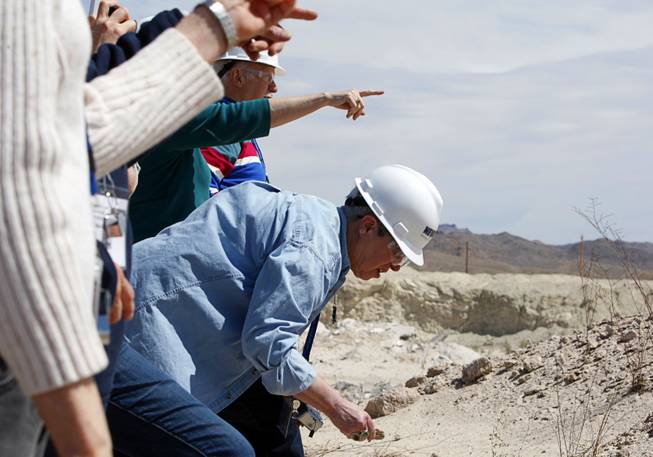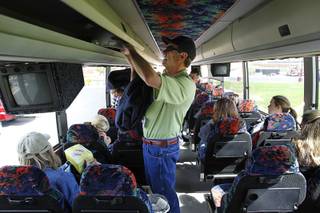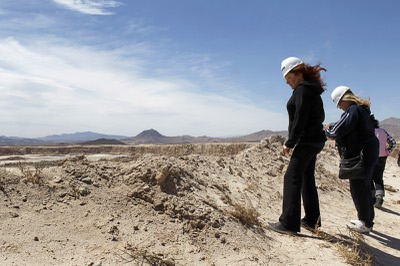
Linda Rickey, a teacher at Sierra Vista High School, looks at gypsum ore during an earth science workshop for teachers Wednesday, April 4, 2012. The workshops are sponsored by the Nevada Mining Association and the Nevada Division of Minerals.
Friday, April 6, 2012 | 2 a.m.
Sun coverage
- Other Voices: Mining industry pays its share of taxes (03-31-2012)
- Initiative to make mining pay more taxes clears hurdle (03-14-2012)
- Mining initiative proponents eviscerate industry complaints in legal brief (3-8-2012)
- Mining industry sues to stop effort to raise its taxes (2-23-2012)
- Lawmakers preparing for mining tax fight (2-5-2012)
- Mining tax could nearly double under proposed initiative (1-31-2012)
- More Sun education stories
The black charter bus rumbles down Pabco Road, heading for a rocky plot of land in the middle of the desert.
Inside are 30 local teachers taking a field trip of sorts. It might seem like a strange kind of role reversal, but it’s spring break in Las Vegas. Supposedly, anything goes.
The Pabco drywall plant looms up ahead as the bus reaches its destination. Lenny Ordway hops on and introduces himself as the office manager overseeing the largest drywall manufacturing operation on the West Coast.
“Let’s go down and have a blast,” he says, hinting at what comes next.
The bus lurches forward toward a nearby gypsum mine.
The teachers are here today as part of an earth science workshop sponsored by the Nevada Mining Association and the Nevada Division of Minerals. The three-day program seeks to educate teachers — and by extension, students — about Nevada’s rich mineral resources and its long, storied history in mining.
Nevada might be known as the Silver State, but it’s actually the fourth-largest gold producer in the world behind China, Australia and South Africa. The state is also a major producer of other minerals such as copper, limestone and magnesium oxide. In 2009, the value of all the mineral production in Nevada, excluding oil and geothermal, was $5.8 billion, according to the mining association.
Twenty-three years ago, the mining association and its state counterpart began conducting geology, topography and earth science workshops for teachers in Reno and Las Vegas. Educational outreach was important not only to give teachers and children a better understanding of mining and Nevada’s mineral resources, but also to dispel what they see as public misconceptions about the mining industry.
“A lot of kids don’t know about mining in Nevada,” says Rachel Wearne, a geologist and geographic information system specialist with the state minerals division. “A lot of people see old mining practices of the state and how no one cleaned up, but that’s not the way mining is done today. It’s a very environmentally friendly and safe process now.”
•••
Mining is a much bigger deal in Northern Nevada. The Mackay School of Earth Science and Engineering, formerly the Mackay School of Mines, is at UNR. Elko’s Cortez Hills gold mine is home to the world’s largest gold producer, Barrick Gold Corp. In 2009, the Toronto-based mining company and others such as Newmont Mining Corp. dug up about 5.6 million ounces of gold in Nevada — at the time worth more than $5 billion — according to the Nevada Mining Association.
However, Southern Nevada has much to offer to Nevada mining and geology teachers, as well, Wearne and other state and mining officials tell teachers on the trip.
The desert landscape at Red Rock Canyon and the Valley of Fire State Park provides a great learning opportunity for geology teachers, with textbook examples of earth science terms such as the “great unconformity,” “syncline folds” and “differential erosion.” Students can see rocks as old as 1.7 billion years littering all around Las Vegas.
Southern Nevada also produces minerals that are crucial to transportation infrastructure (aggregate minerals for roads and gravel landscaping) as well as housing (gypsum for drywall). The production of these minerals helped enable the unprecedented growth of Las Vegas through the last two decades.
California-based Pabco has been at the forefront of the drywall production that helped support the Las Vegas housing boom. Pabco’s Las Vegas plant — located on a 4,600-acre plot of land about 10 miles east of Nellis Air Force Base — is the largest in the valley. In fact, the company is the single largest private landowner in the state, Ordway says.
Mining at Pabco’s Las Vegas plant started in the early 1960s. At the time, Pabco used to scrape gypsum from the land, but new technologies and methods were developed since then. Now, Pabco drills and blasts gypsum.
The bus reaches the outer edges of the gypsum mine. As the teachers get off the bus, Ordway tells them that parts of the 1971 James Bond movie “Diamonds Are Forever” were filmed at the plant and mine.
Ordway — sporting a crisp blue striped shirt, a white hardhat and beard — leads the group out to the open pit mine where nearly 300 years of gypsum is stuck underground. He begins to count down, as teachers — wearing similar white hardhats and holding cameras — wait in anticipation.
“Three, two, one. Fire in the hole,” Ordway says as 210 pounds of an ammonium nitrate and diesel fuel mix is ignited.
The resulting explosion — a few hundred feet away — blasts through the bedrock, jiggering loose about 29,000 tons of gypsum and clay rocks. A plume of tan smoke begins to billow from the blast site.
“Cool, huh?” Ordways says, as teachers look on with awe.
•••
Ordway begins explaining the drywall manufacturing process as he leads the teachers through the manufacturing plant, which produces enough drywall a day to line the innards of 800 homes. Drywall is basically gypsum plaster stuck between two sheets of special paper, Ordway says.
After the blast, massive scoop trucks haul the gypsum-clay mix onto conveyor belts, which bring the rocks to a large evaporation pond where the gypsum is separated from the clay using water from nearby Lake Mead. The gypsum is then dried and heated in gas-fired mills to 350 degrees Fahrenheit to extract the water from the gypsum.
A special concoction of water and other chemicals are added to the gypsum powder, and the resulting slurry is sandwiched between two sheets of recycled paper and reheated to harden, Ordway says.
Ordway pauses to show the teachers how Pabco employees change out a 6,095-pound paper roll, which dispenses six miles of paper down an 1,800-foot-long assembly line at a rate of 440 feet a minute. The line of drywall is so long, workers use small bicycles to traverse the factory floor.
Pabco employees are paid an average of $20 an hour plus benefits and are required to have a high school diploma or GED equivalent, Ordway adds.
“Wow,” a teacher says as she looked around at the entire operation.
•••
The Pabco field trip is one of four field trips that capped a three-day workshop for teachers. During the first day, teachers were given special lesson plans and resources to apply geology and earth science lessons into their curriculum. The second and optional third days were devoted to field trips — to area mines and state parks — that linked what teachers learned in the classroom to real life.
The workshops also help with recertification. Every five years, teachers need six credits of outside professional development to maintain their teaching license. The geology workshops can count for one credit, and it comes at an inexpensive cost: a $1 registration fee.
The Nevada Mining Association budgets about $50,000 a year for the two workshop series in Reno and Las Vegas. The state Division of Minerals puts in about $15,000 a year. The mining association’s education committee — made up of state officials, university professors and mining employees — has been organizing the endeavor for more than two decades.
However, as gold prices have spiked from $250 an ounce to more than $1,700 an ounce in the past decade, folks critical of the mining industry have clamored for the industry to pay a greater share of taxes. Currently, mining taxes are capped at 5 percent, which brought about $200 million to the state’s coffers last year. A ballot initiative is now being considered to raise mining taxes to 9 percent.
Max Stetler, a gifted and talented education teacher at Goldfarb Elementary School, said he was thankful for the workshop. It’s given him many ideas for lessons, but he said he felt the mining industry could contribute more to Nevada’s treasury.
“Mining is good for the economy, providing many jobs, but the earth belongs to everyone,” he said. “I think (the mining industry) should pay their fair share.”
Katie Neddenriep, the education committee chairwoman, said the earth science workshops were meant to be purely educational, focusing on how teachers can incorporate minerals into their curricula and educating them about mine safety and environmental impacts. The purpose of the workshops is to raise awareness of Nevada’s mineral-rich resources and its mining history, she said, not to advocate for any policies.
“We make a real effort to keep them as apolitical as possible,” Neddenriep said. “Teachers will still ask about the tax situation and we will answer to the best of our ability. We don’t skew the information — we give resources that teachers need to fit the needs of the kids.”
Cashman Middle School science teacher Rick Bowersox said he enjoyed his second year of earth science workshops, saying, “It’s the one I look forward to every year.”
As a result of last year’s workshops, Bowersox was able to incorporate a special lesson on fossilization by allowing his students to create their own “fossils” from plaster and clay. A workshop field trip last year to Death Valley National Park also led to an overnight camping trip to the valley this year with his students, many of whom have never left Las Vegas, he added.
Bowersox, who took many pictures of the gypsum mine and blast, said he planned to take the lessons he’d learned from this Pabco visit back to his classroom. He said he hoped his passion for geology would translate into viable education and career options for his students.
“We’re a mineral resources state, and I want my kids to know that,” he said. “This gives us a chance to go into the local Southern Nevada geology and industry and take it back to our kids.”



Join the Discussion:
Check this out for a full explanation of our conversion to the LiveFyre commenting system and instructions on how to sign up for an account.
Full comments policy